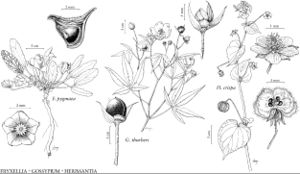Difference between revisions of "Fryxellia pygmaea"
Brittonia 26: 95. 1974.
FNA>Volume Importer |
imported>Volume Importer |
||
| (6 intermediate revisions by 2 users not shown) | |||
| Line 12: | Line 12: | ||
}}{{Treatment/ID/Special_status | }}{{Treatment/ID/Special_status | ||
|code=F | |code=F | ||
| − | |label= | + | |label=Illustrated |
}} | }} | ||
| − | |basionyms={{Treatment/ID/ | + | |basionyms={{Treatment/ID/Basionym |
|name=Anoda pygmaea | |name=Anoda pygmaea | ||
|authority=Correll | |authority=Correll | ||
| + | |rank=species | ||
| + | |publication_title=Wrightia | ||
| + | |publication_place=4: 75. 1968 | ||
}} | }} | ||
|synonyms= | |synonyms= | ||
| Line 34: | Line 37: | ||
|distribution=Tex.;Mexico (Coahuila). | |distribution=Tex.;Mexico (Coahuila). | ||
|discussion=<p>Of conservation concern.</p><!-- | |discussion=<p>Of conservation concern.</p><!-- | ||
| − | --><p>The distribution of Fryxellia pygmaea in the flora area is not known. The type collection (the only collection known from the flora area) was made by Captain John Pope in 1854. It was taken on his survey route from Preston, Grayson County, on the Red River of Texas, southwest to the Pecos River and then nearly west to the valley of the Rio Grande near El Paso and Doña Ana, New Mexico.</p><!-- | + | --><p>The distribution of <i>Fryxellia pygmaea</i> in the flora area is not known. The type collection (the only collection known from the flora area) was made by Captain John Pope in 1854. It was taken on his survey route from Preston, Grayson County, on the Red River of Texas, southwest to the Pecos River and then nearly west to the valley of the Rio Grande near El Paso and Doña Ana, New Mexico.</p><!-- |
| − | --><p>Fryxellia pygmaea is in the Center for Plant Conservation’s National Collection of Endangered Plants.</p> | + | --><p><i>Fryxellia pygmaea</i> is in the Center for Plant Conservation’s National Collection of Endangered Plants.</p> |
|tables= | |tables= | ||
|references= | |references= | ||
| Line 44: | Line 47: | ||
-->{{#Taxon: | -->{{#Taxon: | ||
name=Fryxellia pygmaea | name=Fryxellia pygmaea | ||
| − | |||
|authority=(Correll) D. M. Bates | |authority=(Correll) D. M. Bates | ||
|rank=species | |rank=species | ||
| Line 58: | Line 60: | ||
|publication title=Brittonia | |publication title=Brittonia | ||
|publication year=1974 | |publication year=1974 | ||
| − | |special status=Conservation concern; | + | |special status=Conservation concern;Illustrated |
| − | |source xml=https:// | + | |source xml=https://bitbucket.org/aafc-mbb/fna-data-curation/src/2e0870ddd59836b60bcf96646a41e87ea5a5943a/coarse_grained_fna_xml/V6/V6_452.xml |
|subfamily=Malvaceae subfam. Malvoideae | |subfamily=Malvaceae subfam. Malvoideae | ||
|genus=Fryxellia | |genus=Fryxellia | ||
Latest revision as of 23:21, 5 November 2020
Plants 10–15 cm diam., cespitose; growing points 1+, stems branched below soil surface. Leaf blades to 4 × 2.4 cm. Pedicels not articulated, 10–20 mm. Flowers: calyx subrotate, to 12 mm, to 17 mm in fruit, lobes to 7 × 8 mm (9 × 10 mm in fruit), papery, folded and slightly keeled along each commissural vein; corolla to 15 mm, exceeding calyx; staminal column to 4 mm. Schizocarps 9–10 mm diam., closely invested by calyx; mericarps pale brown, to 3 × 5 mm exclusive of dorsal spurs, spurs to 2 mm. Seeds 2 mm. 2n = 16.
Phenology: Flowering apparently summer.
Habitat: Dry, open slopes
Elevation: 1300 m
Distribution

Tex., Mexico (Coahuila).
Discussion
Of conservation concern.
The distribution of Fryxellia pygmaea in the flora area is not known. The type collection (the only collection known from the flora area) was made by Captain John Pope in 1854. It was taken on his survey route from Preston, Grayson County, on the Red River of Texas, southwest to the Pecos River and then nearly west to the valley of the Rio Grande near El Paso and Doña Ana, New Mexico.
Fryxellia pygmaea is in the Center for Plant Conservation’s National Collection of Endangered Plants.
Selected References
None.
